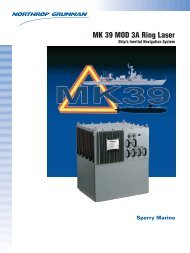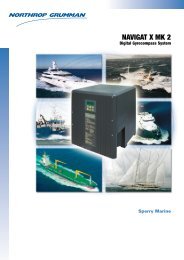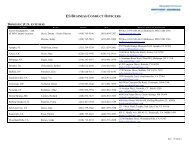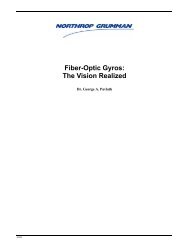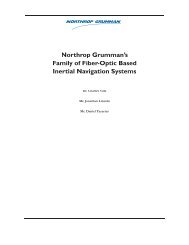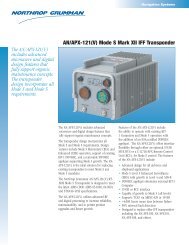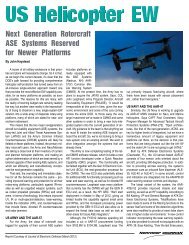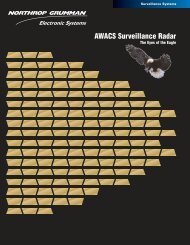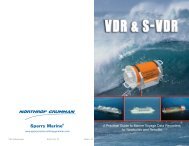Fiber-Optic Acoustic Sensors (FOAS) - Northrop Grumman ...
Fiber-Optic Acoustic Sensors (FOAS) - Northrop Grumman ...
Fiber-Optic Acoustic Sensors (FOAS) - Northrop Grumman ...
Create successful ePaper yourself
Turn your PDF publications into a flip-book with our unique Google optimized e-Paper software.
Legacy<br />
Ceramic Array<br />
Power In<br />
Multiplex<br />
and <strong>Optic</strong>al<br />
Conversion<br />
A/D<br />
Conv.<br />
Sensor<br />
Signal<br />
Cond./<br />
Filters<br />
∆V∆P<br />
Preamp<br />
Hundreds of active electronic and optical components, joints,<br />
connectors and interfaces required for each channel<br />
Light Weight Wide Aperture Array on<br />
Virginia Class Submarines<br />
The Navy’s newest Virginia-class subma-<br />
rines employ a Light Weight Wide Aperture<br />
Array (LWWAA) on its hull for advanced<br />
acoustic detection. The LWWAA system is<br />
a set of large array panels that are mounted<br />
on either side of the submarine, which<br />
provide sonar sensor input to the subma-<br />
rine’s combat system. Instead of traditional<br />
ceramic hydrophone sensors, the<br />
LWWAA uses <strong>FOAS</strong> technologies to con-<br />
vert a target submarine’s acoustic energy in<br />
the water into information that can be used<br />
to identify and track it. <strong>Northrop</strong> <strong>Grumman</strong><br />
designed, developed and manufactures the<br />
key optical sensing elements of this<br />
<strong>FOAS</strong> array.<br />
Towed Arrays<br />
<strong>Northrop</strong> <strong>Grumman</strong> has designed and<br />
developed high channel count fi ber optic<br />
towed arrays for submarine applications.<br />
The performance of these arrays has been<br />
Clock<br />
Synchro<br />
<strong>Acoustic</strong> Event ∆P<br />
λ0<br />
superior to equivalent ceramic arrays and<br />
its ruggedness and reliability have been ex-<br />
ceptional. It is expected that future towed<br />
array systems will transition to fi ber-optic<br />
technology to take advantage of the lower<br />
cost, reliability and ruggedness.<br />
Surveillance Systems<br />
The U.S. Navy and <strong>Northrop</strong> <strong>Grumman</strong><br />
continue to be actively involved in the de-<br />
velopment of all fi ber-optic acoustic sensor<br />
surveillance arrays for anti-submarine war-<br />
fare passive sonar. They may be deployed<br />
in all types of terrain and marine environ-<br />
ments to accommodate such applications<br />
as perimeter security, harbor monitoring,<br />
and ground surveillance. Depending on<br />
the application, these arrays may contain<br />
optical geophones, fi ber-optic hydro-<br />
phones, and/or fi ber-optic microphones.<br />
The Centurion Harbor Surveillance pro-<br />
gram demonstrates our <strong>FOAS</strong> capabilities<br />
in this area.<br />
<strong>Fiber</strong>-<strong>Optic</strong> Array<br />
λ +∆Φ<br />
0<br />
∆Φ/∆P<br />
<strong>Optic</strong>al Interrogation Analog <strong>Optic</strong>al Output<br />
Less than 10 passive components and splices per channel<br />
Other advantages of fi ber-<br />
optic arrays over convention-<br />
al arrays include:<br />
• Lower power requirements<br />
• Increased reliability due to a<br />
simplifi ed array design<br />
• Reduced maintenance costs<br />
• Lower cost to manufacture<br />
• No underwater electrical compo-<br />
nents or wires<br />
• Light weight and small cable<br />
diameter, which facilitate rapid de-<br />
ployment and recovery of the array<br />
• Immunity to electromagnetic<br />
interference (EMI)<br />
• Immunity to high radiation<br />
• Diffi cult to detect since the fi ber-<br />
optic sensor array is not operated<br />
electrically and consists of only<br />
non-metallic materials.



